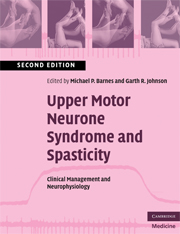Book contents
- Frontmatter
- Contents
- List of Contributors
- Preface to the second edition
- 1 An overview of the clinical management of spasticity
- 2 Neurophysiology of spasticity
- 3 The measurement of spasticity
- 4 Physiotherapy management of spasticity
- 5 Seating and positioning
- 6 Orthoses, splints and casts
- 7 Pharmacological management of spasticity
- 8 Chemical neurolysis in the management of muscle spasticity
- 9 Spasticity and botulinum toxin
- 10 Intrathecal baclofen for the control of spinal and supraspinal spasticity
- 11 Surgical management of spasticity
- 12 Management of spasticity in children
- Index
- References
1 - An overview of the clinical management of spasticity
Published online by Cambridge University Press: 22 August 2009
- Frontmatter
- Contents
- List of Contributors
- Preface to the second edition
- 1 An overview of the clinical management of spasticity
- 2 Neurophysiology of spasticity
- 3 The measurement of spasticity
- 4 Physiotherapy management of spasticity
- 5 Seating and positioning
- 6 Orthoses, splints and casts
- 7 Pharmacological management of spasticity
- 8 Chemical neurolysis in the management of muscle spasticity
- 9 Spasticity and botulinum toxin
- 10 Intrathecal baclofen for the control of spinal and supraspinal spasticity
- 11 Surgical management of spasticity
- 12 Management of spasticity in children
- Index
- References
Summary
Spasticity can cause significant problems with activity and participation in people with a variety of neurological disorders. It can represent a major challenge to the rehabilitation team. However, modern approaches to management, making the best use of new drugs and new techniques, can produce significant benefits for the disabled person. The details of these techniques are outlined in later chapters and each chapter has a thorough reference list. The purpose of this initial chapter is to provide a general overview of spasticity management, and it attempts to put the later chapters into a coherent context.
Definitions of spasticity and the upper motor neurone syndrome
Spasticity has been given a fairly strict and narrow physiologically based definition, which is now widely accepted (Lance, 1980):
Spasticity is motor disorder characterised by a velocity dependent increase in tonic stretch reflexes (muscle tone) with exaggerated tendon jerks, resulting from hyper-excitability of the stretch reflex, as one component of the upper motor neurone syndrome.
This definition emphasizes the fact that spasticity is only one of the many different features of the upper motor neurone (UMN) syndrome. The UMN syndrome is a somewhat vague but nevertheless useful concept. Many of the features of the UMN syndrome are actually more responsible for disability, and consequent problems of participation, than the more narrowly defined spasticity itself. The UMN syndrome can occur following any lesion affecting some or all of the descending motor pathways.
Keywords
- Type
- Chapter
- Information
- Upper Motor Neurone Syndrome and SpasticityClinical Management and Neurophysiology, pp. 1 - 8Publisher: Cambridge University PressPrint publication year: 2008
References
- 13
- Cited by



